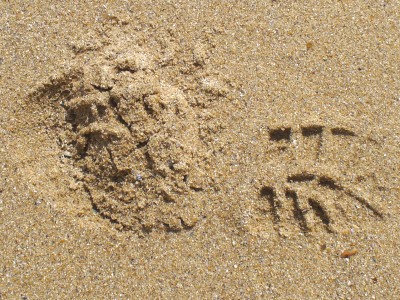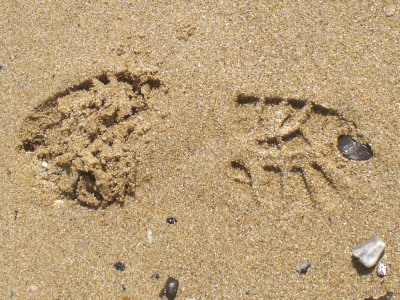Walking in the Wild
Having mastered the techniques of moving quietly on the pavement, the next objective is to transfer that skill to the real ground surfaces of the wild. Some of the most challenging include squelchy mud, leaf litter both wet and dry, long grass, grit, woodland undergrowth and shingle. And of course fresh snow - it's almost impossible to walk silently in newly fallen snow more than about an inch (25 mm) thick.
The critical secret - common sense really - is to take account of what you're standing on, pay attention to where you're about to step, and avoid landing on things that will make a loud or threatening noise. So don't put your foot down on a dry twig, don't land in a deep puddle, avoid treading on deep layers of dry leaves and tripping over brambles. Never force your way through undergrowth or long grass or grab a tree branch in passing - always work your way round such obstacles. Step past - not on - grit and small stones on tracks and paths. If it's so muddy you have to wear Wellington boots, adapt your walking technique by lifting your foot higher and pointing your toe down more so the heel of the leading boot clears the ground.
Practice walking in woodland undergrowth. Choose a place with patches of deep nettle and bramble and also open spaces so you force yourself to circumvent obstacles. Practice in early Spring after rain, at high Summer and during a dry spell in early Winter. For a real challenge, test yourself on fresh snow. Walk, observe and remember. Visit the seashore. Move as quietly as you can across deep shingle. It's impossible to be silent there, but adjust your balance and your tread until you hear a real difference, and practice until you can do it without thinking.
 Then move to a sandy beach and walk across it so as to leave the lightest and most precise footprints you can. To start with you'll probably kick up sand into scuff marks and leave deep heel marks. This footprint shows evidence of the walker landing hard on their heel and twisting their foot when pushing off for the next step - partly due to wearing a heavy boot with an inflexible highly arched sole, but mainly to poor walking technique.
Then move to a sandy beach and walk across it so as to leave the lightest and most precise footprints you can. To start with you'll probably kick up sand into scuff marks and leave deep heel marks. This footprint shows evidence of the walker landing hard on their heel and twisting their foot when pushing off for the next step - partly due to wearing a heavy boot with an inflexible highly arched sole, but mainly to poor walking technique.
Although relatively lightly shod on the unforgiving concrete and asphalt surfaces of our towns, most of us don rigid heavy boots with thick soles when we set out onto the soft resilient earth and grasses of the wild - almost as if we're afraid of making contact with the natural world beneath our feet. Both the footprints here show the rigidity and excess arching of the boot - the arch of the boot has not made contact with the sand, although both toe and heel have dug in quite deeply. The boot in question has artificial "arch supports", preventing the natural spring of the arch operating.
 But even in unsuitable footwear, a great improvement can be made by landing as far as possible on the flat of your foot rather than on the heel first. The depth of an impression in sand is proportional to the loading per unit area, so the greater the area of your foot that bears your weight, the lighter the impression. This footprint is much lighter, but the walker has clearly slewed to their left as they stepped forwards. So put on light flexible shoes and practice until your footprints in the sand are shallow, of even depth and clearly defined.
But even in unsuitable footwear, a great improvement can be made by landing as far as possible on the flat of your foot rather than on the heel first. The depth of an impression in sand is proportional to the loading per unit area, so the greater the area of your foot that bears your weight, the lighter the impression. This footprint is much lighter, but the walker has clearly slewed to their left as they stepped forwards. So put on light flexible shoes and practice until your footprints in the sand are shallow, of even depth and clearly defined.
These are some of the basics of walking quietly in the wild - maximise the flexibility of your stride, lift your feet clear of the ground cleanly, land progressively from toe to heel, avoid twisting or scuffing your feet. But beyond the obvious, only experience will guide you. No-one can be taught to ride a bicycle by correspondence course. Equally, you'll have to find out for yourself the result of treading unwisely and wisely through the wild. Practice and practice again, until you can tell what you're standing on by the feel of your foot and judge immediately by looking where your foot is about to fall whether it will make an unwanted noise or not. Practice until you can decide immediately where to step instead, so you can keep moving despite the unexpected.
Practice walking in woodland undergrowth. Choose a place with patches of deep nettle and bramble and also open spaces so you force yourself to circumvent obstacles. Practice in early Spring after rain, at high Summer and during a dry spell in early Winter. For a real challenge, test yourself on fresh snow. Walk, observe and remember. Visit the seashore. Move as quietly as you can across deep shingle. It's impossible to be silent there, but adjust your balance and your tread until you hear a real difference, and practice until you can do it without thinking.
 Then move to a sandy beach and walk across it so as to leave the lightest and most precise footprints you can. To start with you'll probably kick up sand into scuff marks and leave deep heel marks. This footprint shows evidence of the walker landing hard on their heel and twisting their foot when pushing off for the next step - partly due to wearing a heavy boot with an inflexible highly arched sole, but mainly to poor walking technique.
Then move to a sandy beach and walk across it so as to leave the lightest and most precise footprints you can. To start with you'll probably kick up sand into scuff marks and leave deep heel marks. This footprint shows evidence of the walker landing hard on their heel and twisting their foot when pushing off for the next step - partly due to wearing a heavy boot with an inflexible highly arched sole, but mainly to poor walking technique.Although relatively lightly shod on the unforgiving concrete and asphalt surfaces of our towns, most of us don rigid heavy boots with thick soles when we set out onto the soft resilient earth and grasses of the wild - almost as if we're afraid of making contact with the natural world beneath our feet. Both the footprints here show the rigidity and excess arching of the boot - the arch of the boot has not made contact with the sand, although both toe and heel have dug in quite deeply. The boot in question has artificial "arch supports", preventing the natural spring of the arch operating.
 But even in unsuitable footwear, a great improvement can be made by landing as far as possible on the flat of your foot rather than on the heel first. The depth of an impression in sand is proportional to the loading per unit area, so the greater the area of your foot that bears your weight, the lighter the impression. This footprint is much lighter, but the walker has clearly slewed to their left as they stepped forwards. So put on light flexible shoes and practice until your footprints in the sand are shallow, of even depth and clearly defined.
But even in unsuitable footwear, a great improvement can be made by landing as far as possible on the flat of your foot rather than on the heel first. The depth of an impression in sand is proportional to the loading per unit area, so the greater the area of your foot that bears your weight, the lighter the impression. This footprint is much lighter, but the walker has clearly slewed to their left as they stepped forwards. So put on light flexible shoes and practice until your footprints in the sand are shallow, of even depth and clearly defined.These are some of the basics of walking quietly in the wild - maximise the flexibility of your stride, lift your feet clear of the ground cleanly, land progressively from toe to heel, avoid twisting or scuffing your feet. But beyond the obvious, only experience will guide you. No-one can be taught to ride a bicycle by correspondence course. Equally, you'll have to find out for yourself the result of treading unwisely and wisely through the wild. Practice and practice again, until you can tell what you're standing on by the feel of your foot and judge immediately by looking where your foot is about to fall whether it will make an unwanted noise or not. Practice until you can decide immediately where to step instead, so you can keep moving despite the unexpected.
